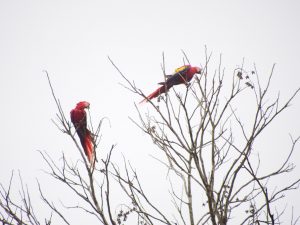Three days after setting them up, it was time to retrieve our camera traps. Our morning hike was significantly shorter than Friday’s corresponding hike, taking half as long. A combination of a faster walking pace, increased endurance, and fewer stops to study wildlife accounted for this.
Our afternoon hike was not as seamless, as it took approximately the same amount of time as its earlier counterpart. GPS in hand, I was responsible for leading my class to retrieve one of our camera traps. I faced extreme difficulty in leading, spiraling around the site of the trap, unable to pinpoint its location on the device. My frustration was escalated with the knowledge that twelve other people were watching me and following me through the lignified labyrinth.
After dinner, my class and I analyzed the images from the camera traps. Sometimes our subjects, like the ocelots and the great curassow, bolted from the flash of the camera. Other times, our subjects, like the pacas and peccaries, lingered, unfazed by the flash.
Being the subject of viewership can emote a spectrum of feelings and behaviors. It can drive one to linger to flee or to the edge of insanity.
One set of organisms uninhibited by the spotlight is the scarlet macaws. The macaws made regular appearances around the research site. Today, three of them perched on a Spanish cedar (Cedrela odorata) directly in my class’ line of vision and later moved to a nearby avocado tree (Persea americana). Both of these trees were in an open clearing. The Spanish cedar was large with a pale gray trunk and was primarily leafless. Very little animal activity occurred on this tree, apart from the macaws’ brief visit. The avocado tree had branches that extended laterally and were dense with medium-sized broad leaves.
Deeply saturated with vibrant red, yellow, and blue, the macaws hardly camouflaged with their surroundings. They also call out in cacophonous caws, attracting attention to themselves. These characteristics render scarlet macaws as easy targets of poachers, who sell these majestic creatures into the pet trade.

It’s heartbreaking that not only the scarlet macaws but also the ocelots, pacas, and many other animals are subject to poaching – One animal, man, exploiting the beauty or resources of other animals for economic gain. No matter how advanced society becomes, avarice triumphs, for both local poachers and wealthy foreign collectors.
In an undisturbed ecosystem, there is balance. There is predation, parasitism, and competition, but there is balance.
Despite how advanced humans are, there is something we could learn from nature.
